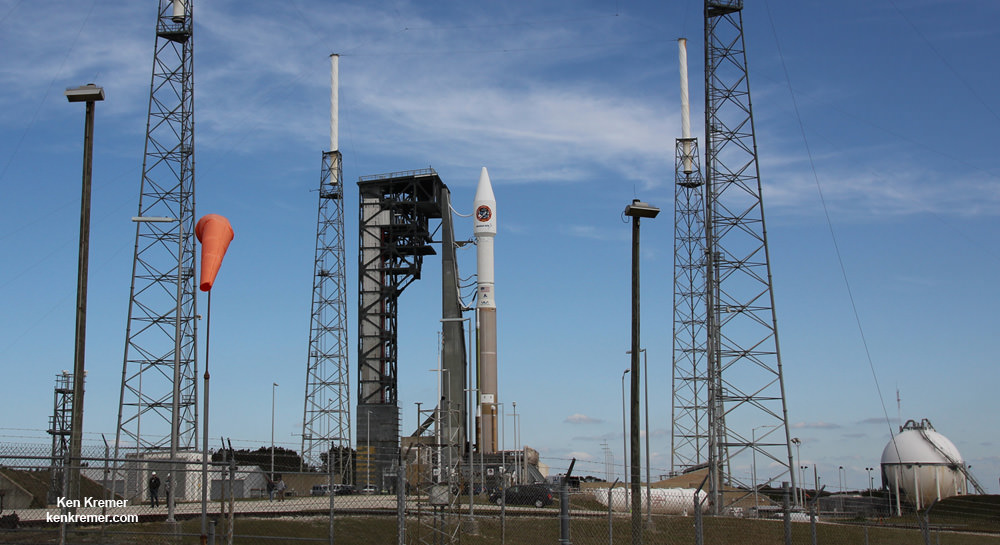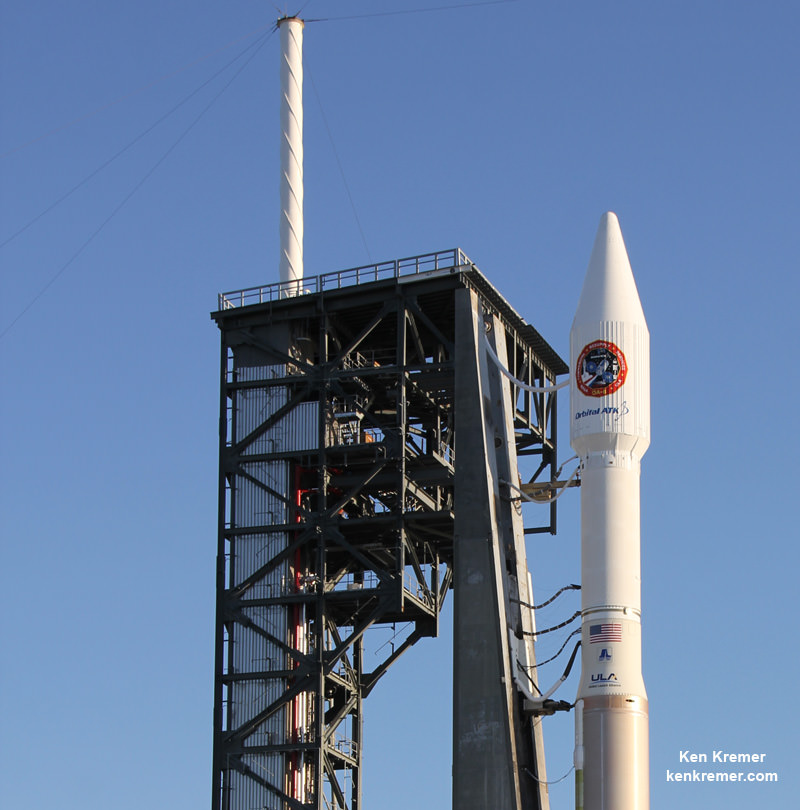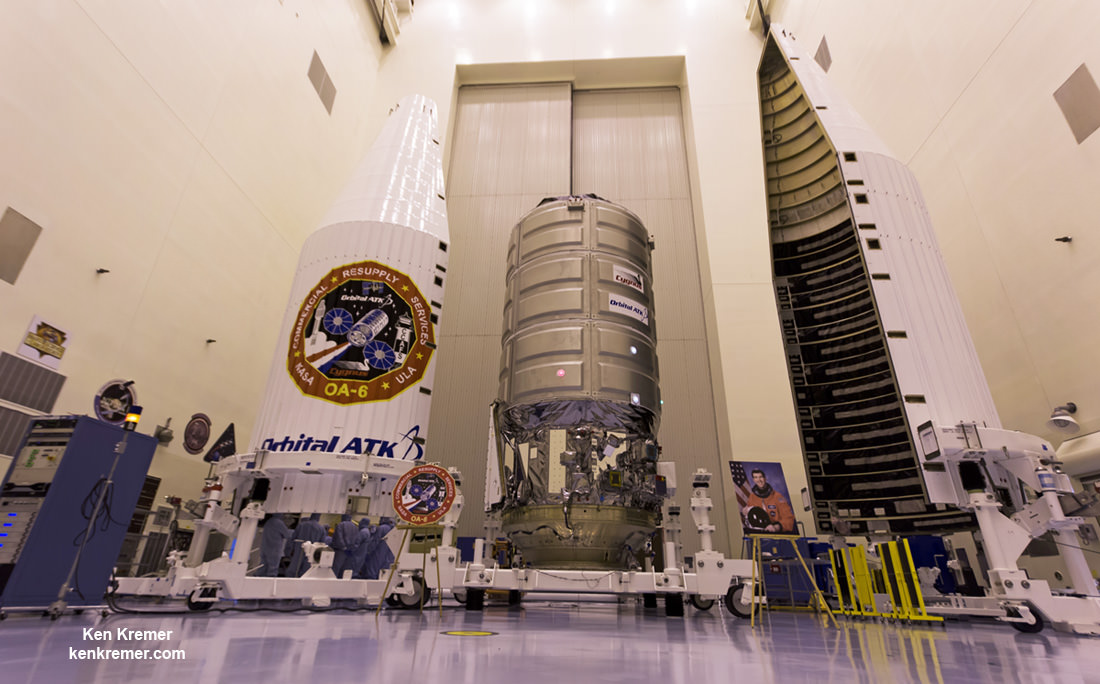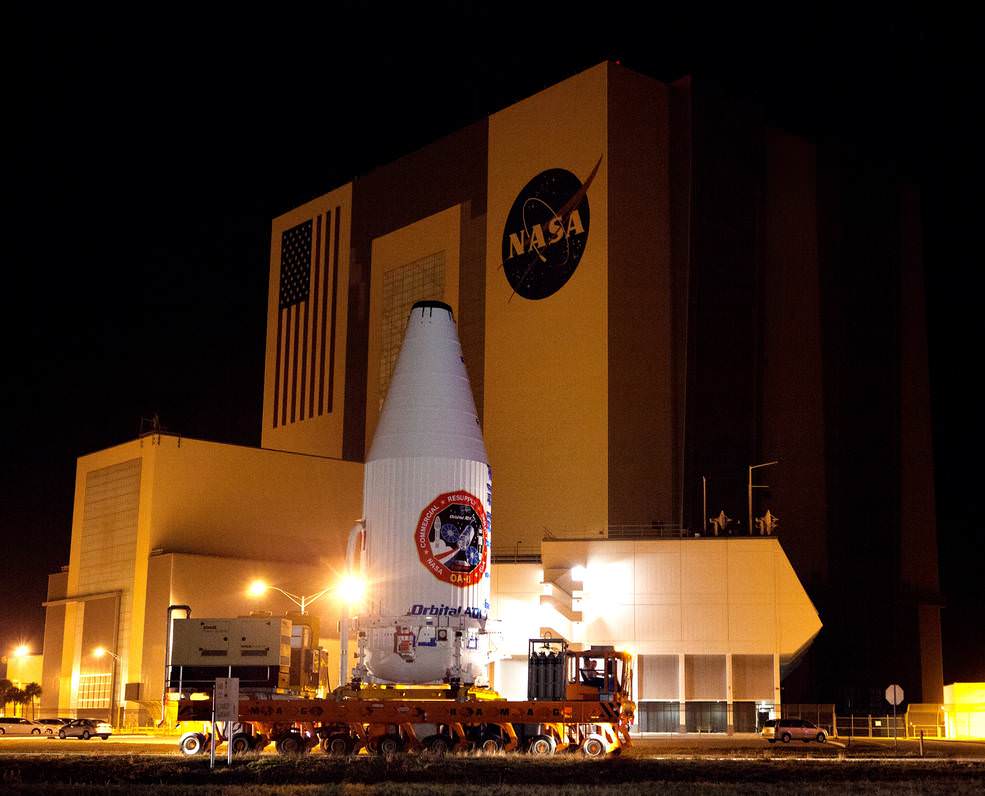
KENNEDY SPACE CENTER, FL – Clear skies and a nearly full Moon offer the distinct possibility to witness an astronomical launch spectacular for all those who have traveled near and far to witness the nighttime liftoff of an Orbital ATK Cygnus commercial cargo mission for NASA to the space station on Tuesday night, March 22.
With the heaviest Cygnus ever bolted atop and packed to the gills with science and supplies for the six person crew living and working aboard the International Space Station (ISS), a venerable United Launch Alliance Atlas V rocket is due to blastoff on March 22, at 11:05 p.m. EDT from Cape Canaveral Air Force Station in Florida.
The nighttime liftoff is targeted for 11:05 PM EDT March 22, at the opening of a 30 minute launch window from Space Launch Complex 41 at Cape Canaveral Air Force Station in Florida.
The ULA Atlas V rocket will liftoff on the CRS-6 resupply mission with the private Orbital ATK Cygnus spacecraft under a commercial resupply services (CRS) contract to NASA.
The Atlas V/Cygnus CRS-6 launch coverage will be broadcast on NASA TV and the NASA launch blog beginning at 10 PM, Tuesday night.
You can watch the launch live at – http://www.nasa.gov/multimedia/nasatv/index.html
NASA will also provide additional live coverage overnight of the critical solar array deployment at 12:45 a.m. March 23 followed be a post-launch briefing will be approximately two hours after launch.
The weather forecast has been upgraded and currently calls for an unusually favorable 90 percent chance of acceptable conditions at launch time.

In case of a delay for any reason due to weather or technical issues the back up launch opportunity is slight earlier at 10:40 p.m. Wednesday, March 23. NASA TV coverage would start at 9:45 p.m.
The spacecraft will arrive at the station on Saturday, March 26, at which time Expedition 47 Commander Tim Kopra of NASA and Flight Engineer Tim Peake of ESA (European Space Agency) will grapple Cygnus, using the space station’s robotic arm, at approximately 6:40 a.m. NASA TV coverage of rendezvous and grapple will begin at 5:30 a.m.

The commercial Cygnus cargo freighter was built by Orbital ATK, based in Dulles, Virginia.
The Cygnus has been named the S.S. Rick Husband in honor of Col. Rick Husband, the late commander of Space Shuttle Columbia, which was tragically lost with its crew of seven NASA astronauts during re-entry on its final flight on Feb. 1, 2003.
This flight is also known as OA-6 and is being launched under terms of the firm’s Commercial Resupply Services (CRS) contract with NASA. It also counts as Orbital ATK’s fifth cargo delivery mission to the space station.
OA-6 is loaded with 3513 kg (7700 pounds) of science experiments and hardware, crew supplies, spare parts, gear and station hardware to the orbital laboratory in support over 250 research experiments being conducted on board by the Expedition 47 and 48 crews.
About a quarter of the cargo is devoted to science and research gear. The cargo includes 3279 kg of science investigations, 1139 kg of crew supplies, 1108 kg of vehicle hardware, 157 kg of spacewalk equipment, and 98 kg of computer resources.
Here a NASA description of a few of the scientific highlights:
– Gecko Gripper, testing a mechanism similar to the tiny hairs on geckos’ feet that lets them stick to surfaces using an adhesive that doesn’t wear off.
– Strata-1, designed to evaluate how soil on small, airless bodies such as asteroids behaves in microgravity.
– Meteor, an instrument to evaluate from space the chemical composition of meteors entering Earth’s atmosphere. The instrument is being re-flown following its loss on earlier supply missions.
– Saffire, which will set a large fire inside the Cygnus in an unprecedented study to see how large fires behave in space. The research is vital to selecting systems and designing procedures future crews of long-duration missions can use for fighting fires.
– Cygnus is carrying more than two dozen nanosatellites that will be ejected from either the spacecraft or the station at various times during the mission to evaluate a range of technology and science including Earth observations.
When the ISS Expedition 47 crew members open the hatch, they will be greeted with a sign noting the spacecraft was named ‘SS Rick Husband’ in honor of the STS-107 mission commander.

Cygnus will spend approximately two months docked at the ISS.
OA-6 is only the second Cygnus to be launched atop a ULA Atlas V rocket, following the OA-4 mission last December.
The CRS-6/OA-6 flight is also the second flight of the enhanced Cygnus variant, that is over 1 meter longer and sports 50% more volume capability.
Thus it is capable of carrying a much heavier payload of some 3500 kg (7700 lbs) vs. a maximum of 2300 kg (5070 lbs) for the standard version.
Watch for Ken’s onsite launch reports direct from the Kennedy Space Center in Florida.
Stay tuned here for Ken’s continuing Earth and planetary science and human spaceflight news.

………….
Learn more about Orbital ATK Cygnus, ISS, ULA Atlas rocket, SpaceX, Boeing, Space Taxis, Mars rovers, Orion, SLS, Antares, NASA missions and more at Ken’s upcoming outreach events:
Mar 21/22: “Orbital ATK Atlas/Cygnus launch to the ISS, ULA, SpaceX, SLS, Orion, Commercial crew, Curiosity explores Mars, Pluto and more,” Kennedy Space Center Quality Inn, Titusville, FL, evening Mar 21 /late afternoon Mar 22

There is something wrong with the numbers for the mass of the payload:
3279+1139+1108+157+98 = 5781 (kg).
This exceeds the stated maximum payload of 3500 kg by a whopping 65%.